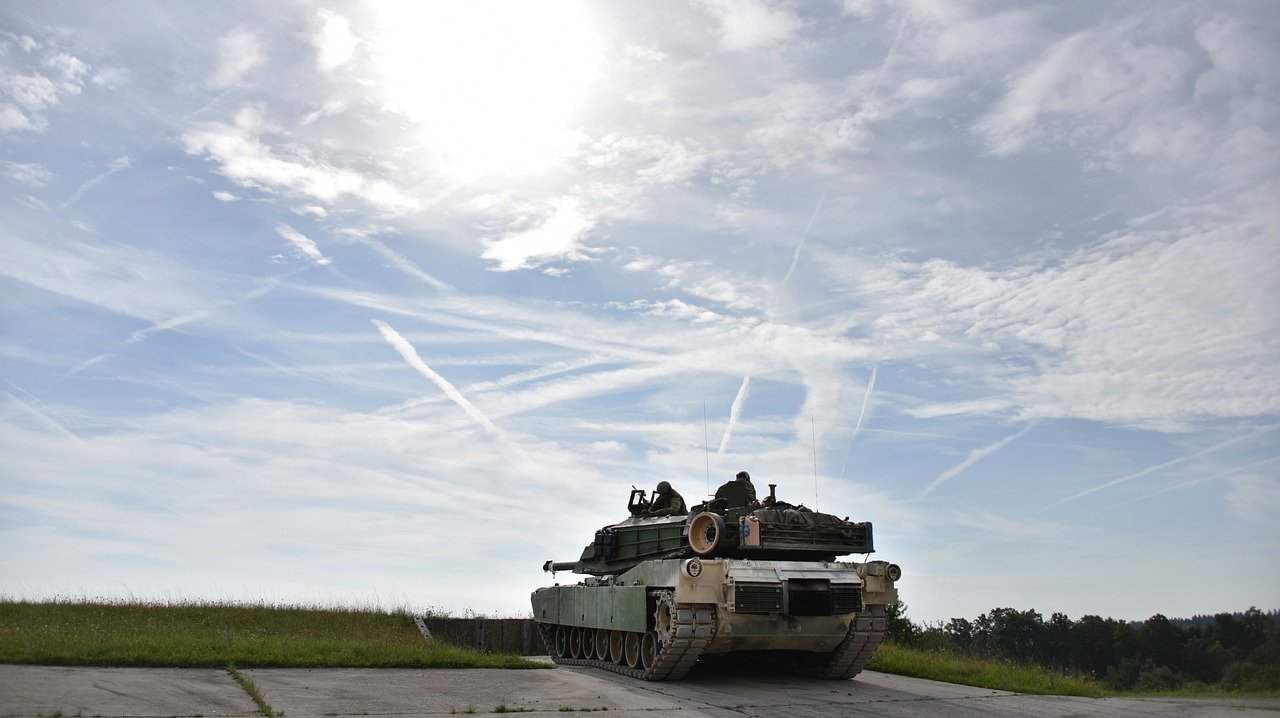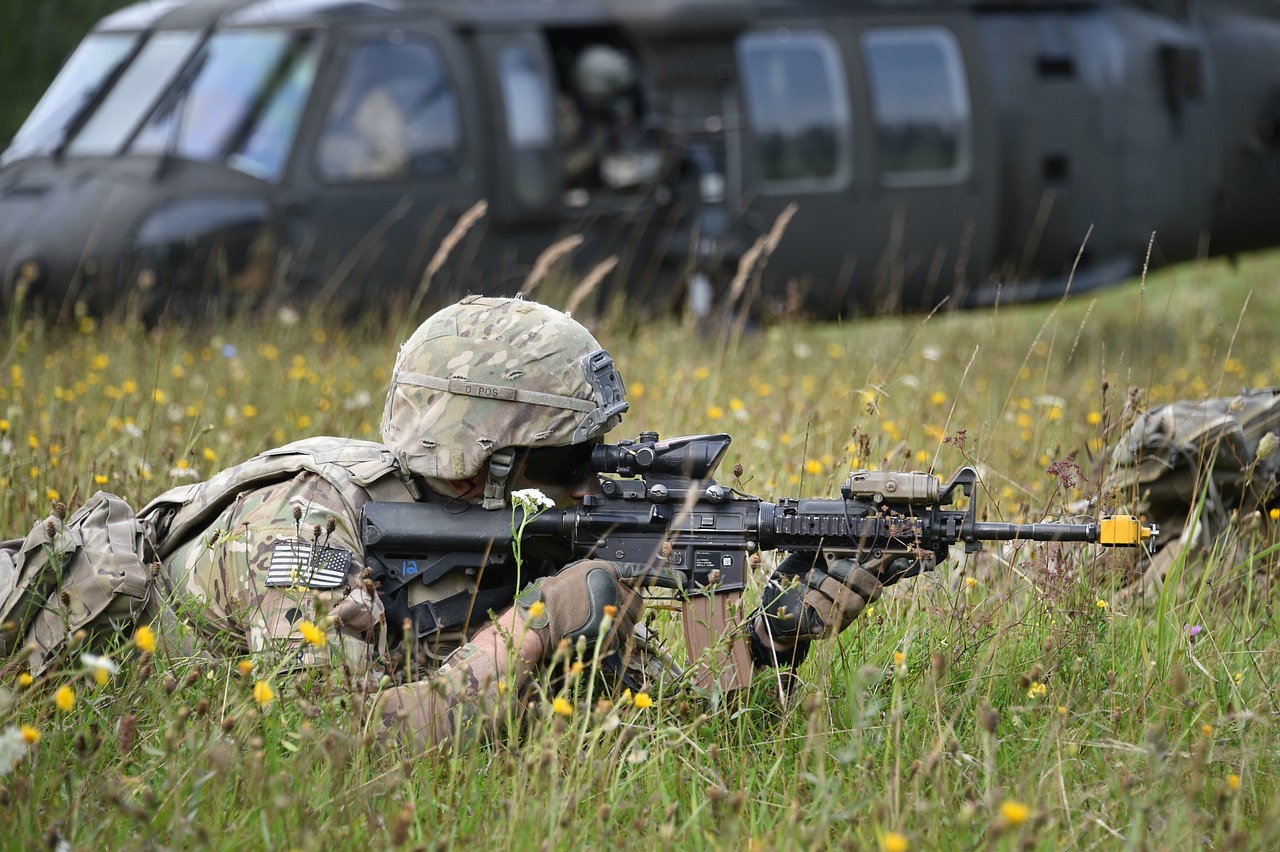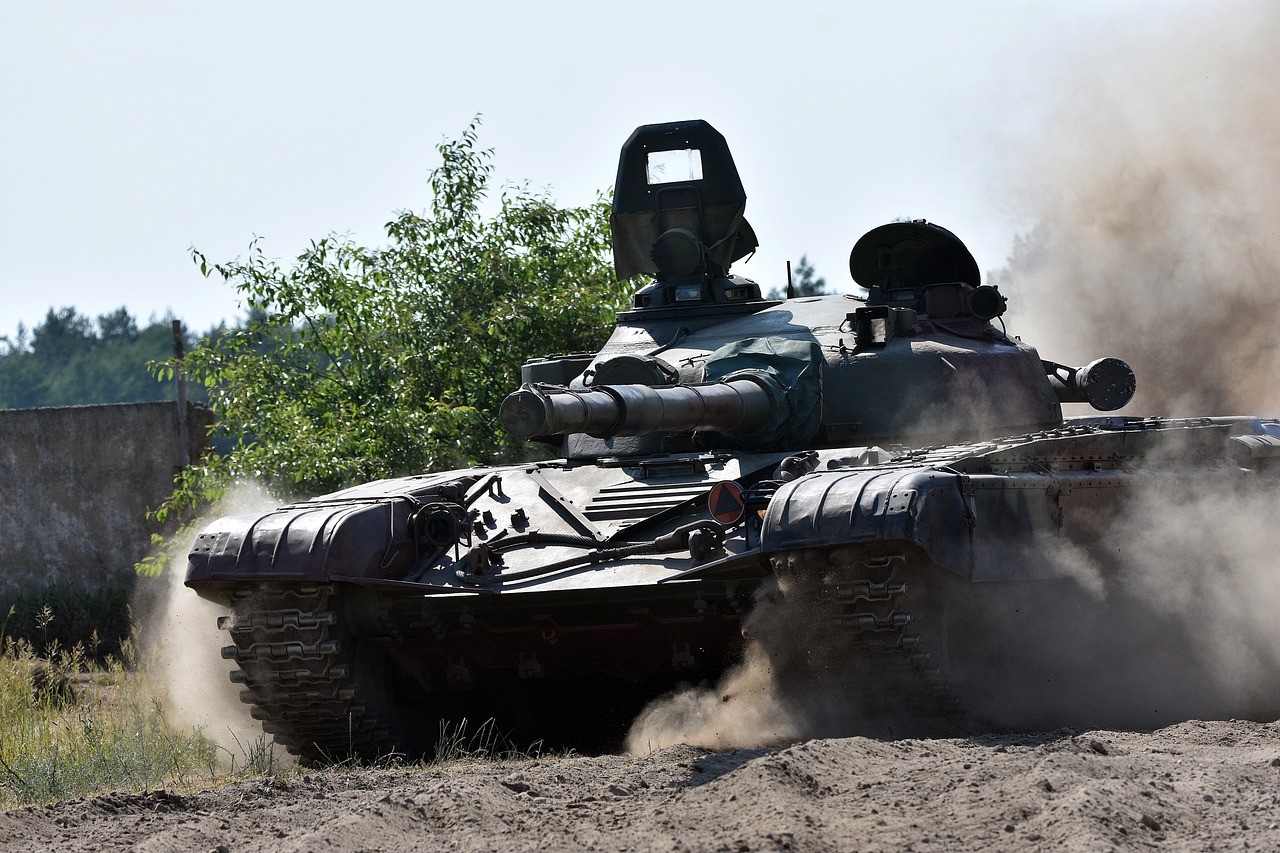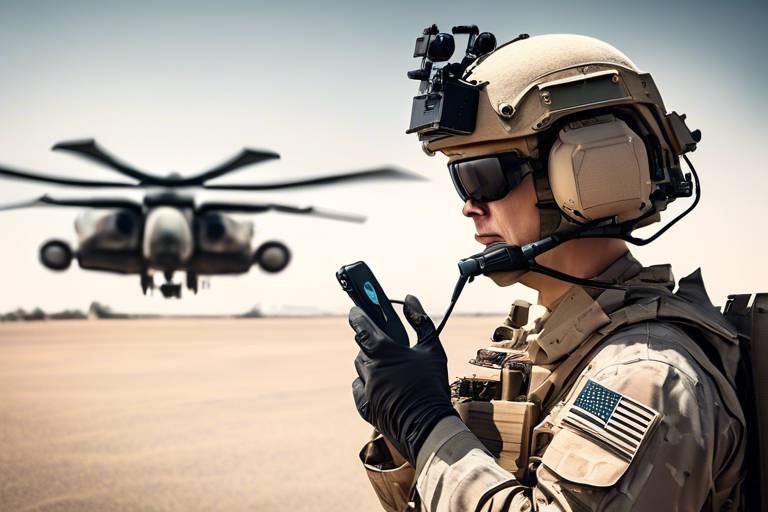AI-Enhanced Data Collection in Battlefield Reconnaissance
In the ever-evolving landscape of military operations, the incorporation of Artificial Intelligence (AI) into battlefield reconnaissance signifies a monumental shift in how data is collected, analyzed, and utilized. Imagine a battlefield where decisions are made not just on instinct but backed by a wealth of real-time information and predictive analytics. This is the future that AI promises, transforming traditional methods into a sophisticated web of interconnected technologies designed to enhance operational efficiency and mission success.
At the heart of this transformation lies the ability to gather and process vast amounts of data swiftly. Reconnaissance missions, once reliant on human observation and limited technological support, now leverage AI to sift through mountains of information—from satellite imagery to drone feeds—allowing military personnel to focus on strategy rather than data collection. The result? A more informed and agile response to threats, ensuring that military forces can adapt to the fluid dynamics of modern warfare.
AI's role in battlefield reconnaissance is not merely a trend; it's a necessity in today's combat environments. As conflicts grow more complex and unpredictable, the need for advanced analytics and real-time processing becomes paramount. AI technologies are like a digital compass, guiding military operations through the fog of war with pinpoint accuracy. By enhancing situational awareness and improving threat detection, AI is not just changing the game; it’s rewriting the rules entirely.
Furthermore, the integration of AI into military reconnaissance is akin to upgrading from a horse and buggy to a high-speed train. The efficiency and speed at which data is analyzed and decisions are made can mean the difference between victory and defeat. With AI, military forces can anticipate enemy movements, assess potential risks, and allocate resources more strategically than ever before. This leap in capability is not just about technology; it's about saving lives and ensuring mission success in the most challenging environments.
As we delve deeper into the various AI technologies employed in battlefield reconnaissance, it becomes clear that the future of military operations is bright, albeit complex. The potential of AI to enhance data collection and analysis is immense, but it also comes with its own set of challenges that must be navigated carefully.
AI is revolutionizing modern warfare by providing advanced analytics, predictive capabilities, and real-time data processing, enabling military forces to make informed decisions swiftly and accurately in dynamic combat environments.
Various AI technologies, including machine learning, computer vision, and natural language processing, are employed in battlefield reconnaissance to gather and analyze vast amounts of data efficiently, enhancing situational awareness and threat detection.
Machine learning algorithms are pivotal in analyzing patterns from historical data, allowing military analysts to predict enemy movements and behaviors, ultimately leading to more strategic planning and resource allocation.
Understanding the difference between supervised and unsupervised learning is crucial for selecting the appropriate model for specific reconnaissance tasks, impacting the effectiveness of data interpretation and actionable insights.
Real-time data processing capabilities enable military units to receive immediate feedback from reconnaissance missions, facilitating rapid responses to emerging threats and enhancing operational readiness on the battlefield.
Computer vision technologies are instrumental in identifying and classifying objects from aerial imagery and video feeds, improving target recognition and reducing the likelihood of friendly fire incidents during operations.
Despite its advantages, the integration of AI in battlefield reconnaissance faces challenges such as data security, ethical concerns, and the need for robust training datasets to ensure reliable performance in critical situations.
Protecting sensitive data collected during reconnaissance missions is paramount, as breaches can lead to compromised operations and exposure of strategic military capabilities to adversaries.
The deployment of AI in military settings raises ethical questions regarding accountability, decision-making, and the potential for unintended consequences, necessitating careful consideration and guidelines for responsible use.
- What is AI-enhanced data collection? - It refers to the use of artificial intelligence technologies to gather, analyze, and interpret data more efficiently and accurately in military reconnaissance.
- How does AI improve battlefield reconnaissance? - AI enhances reconnaissance by providing real-time analytics, predictive capabilities, and improved situational awareness, enabling quicker and more informed decisions.
- What are the challenges of using AI in military operations? - Challenges include data security concerns, ethical implications, and the need for high-quality training data to ensure reliable AI performance.

The Role of AI in Modern Warfare
AI is not just a buzzword in the tech world; it’s a game-changer in modern warfare. Imagine a battlefield where every decision is backed by data-driven insights, where military forces can predict enemy movements with uncanny accuracy, and where operational efficiency reaches new heights. Sounds like something out of a sci-fi movie, right? Well, it's happening right now! AI is revolutionizing the way military operations are conducted by providing advanced analytics and real-time data processing capabilities. This means that commanders can make informed decisions swiftly and accurately, even in the most dynamic combat environments.
One of the most significant impacts of AI in warfare is its ability to process vast amounts of information in real-time. Traditional methods of gathering intelligence can be slow and cumbersome, but AI can analyze data from various sources—satellite images, drone footage, and even social media—almost instantaneously. This rapid analysis allows for a more agile response to threats and enhances situational awareness.
Consider this: in a typical reconnaissance mission, a team might collect hours of video footage. Without AI, analyzing that footage could take days or even weeks. However, with AI algorithms, the system can sift through the data, identifying key patterns and anomalies in a fraction of the time. This not only saves valuable time but also ensures that critical information is not overlooked.
Moreover, AI's predictive capabilities are crucial in modern warfare. By analyzing historical data, machine learning models can foresee potential enemy strategies and movements. This foresight allows military planners to allocate resources more strategically and prepare for various scenarios. Think of it as having a chess master who can predict the opponent's moves several steps ahead.
However, the integration of AI into military operations is not without its challenges. For instance, the reliance on technology raises questions about data security and the ethical implications of decision-making. The stakes are incredibly high, and the consequences of a miscalculation can be dire. Therefore, it’s essential to establish guidelines that ensure responsible use of AI in military settings.
In summary, the role of AI in modern warfare is transformative. It enhances decision-making, operational efficiency, and overall mission success. As military forces continue to embrace these advanced technologies, the landscape of warfare will undoubtedly evolve, making the battlefield more complex yet more manageable through the power of AI.
- What are the main benefits of AI in modern warfare?
AI enhances decision-making, improves operational efficiency, and allows for real-time data processing, making military operations more effective. - How does AI improve battlefield reconnaissance?
AI analyzes vast amounts of data quickly, providing insights that help predict enemy movements and improve situational awareness. - What challenges does AI face in military applications?
Challenges include data security concerns, ethical implications, and the need for robust training datasets.

Types of AI Technologies Used
When we talk about AI technologies deployed in battlefield reconnaissance, we're diving into a realm of innovation that is nothing short of revolutionary. These technologies are the backbone of modern military operations, enabling forces to gather and analyze data more efficiently than ever before. The intricate dance of machine learning, computer vision, and natural language processing is what sets the stage for enhanced situational awareness and improved decision-making. Let's break these down and see how they contribute to the battlefield.
Machine Learning is a cornerstone of AI technology. It allows systems to learn from data patterns, making it possible to predict enemy movements and behaviors with remarkable accuracy. Imagine a chess game where the AI not only learns from past moves but also anticipates future strategies. That's the kind of predictive power machine learning brings to military analysis. By sifting through historical data, these algorithms can identify trends and anomalies that inform strategic planning and resource allocation.
Now, you might wonder how machine learning actually works in this context. It primarily operates through two types of learning: supervised and unsupervised. Supervised learning involves training a model on labeled data, where the outcomes are known, allowing the AI to learn from examples. On the other hand, unsupervised learning deals with unlabeled data, where the AI must find patterns and structures on its own. Each method has its own applications in reconnaissance, impacting everything from data interpretation to actionable insights.
Next up is computer vision, another powerful AI technology that plays a critical role in battlefield reconnaissance. This technology enables military systems to analyze images and video feeds, identifying and classifying objects with high precision. Picture a drone flying over enemy territory, relaying real-time video back to command. With computer vision, the system can automatically detect vehicles, personnel, and even potential threats, significantly improving target recognition. This capability not only enhances operational efficiency but also reduces the risk of friendly fire incidents, a crucial factor in modern warfare.
Additionally, the integration of natural language processing (NLP) is transforming how military personnel interact with data. NLP allows for the analysis of vast amounts of textual information, such as reports, communications, and social media feeds. By processing this data, AI can extract insights that inform decision-making and operational strategies. Imagine the power of sifting through thousands of messages to pinpoint critical information that could change the course of a mission!
In summary, the combination of these AI technologies—machine learning, computer vision, and natural language processing—forms a robust framework for enhancing battlefield reconnaissance. They work together to provide military forces with the tools needed to make informed decisions swiftly and accurately, ultimately leading to increased operational efficiency and mission success.
- What is machine learning in military applications? - Machine learning involves algorithms that analyze historical data to predict future actions, enhancing strategic planning and decision-making.
- How does computer vision improve reconnaissance? - Computer vision enables the identification and classification of objects in real-time, improving target recognition and reducing friendly fire incidents.
- What role does natural language processing play in AI technologies? - NLP processes and analyzes textual data, extracting valuable insights that aid military operations and decision-making.
- What are the challenges of implementing AI in battlefield reconnaissance? - Challenges include data security, ethical concerns, and the need for high-quality training datasets.

Machine Learning Algorithms
Machine learning algorithms are at the heart of modern battlefield reconnaissance, acting as the brain behind the operations that analyze vast amounts of data collected from various sources. Imagine having a super-smart assistant who can sift through mountains of information in seconds, identifying patterns and making predictions that would take a human analyst days or even weeks to uncover. This capability is not just a luxury; it’s a necessity in the fast-paced environment of warfare where every second counts.
By leveraging machine learning algorithms, military analysts can detect subtle trends in historical data that reveal enemy movements and behaviors. For instance, these algorithms can analyze previous battle scenarios and draw insights that inform future strategies. The predictive nature of these algorithms means that they can forecast potential threats before they materialize, allowing commanders to adjust their tactics proactively. This not only enhances situational awareness but also improves resource allocation, ensuring that troops are deployed effectively and efficiently.
Types of Machine Learning Algorithms
To dive deeper, machine learning can be categorized primarily into two types: supervised learning and unsupervised learning. Each type plays a distinct role in reconnaissance efforts:
- Supervised Learning: This approach involves training algorithms on labeled datasets, where the outcomes are known. For example, if the algorithm is trained with images of enemy vehicles, it learns to identify and classify these vehicles in real-time reconnaissance footage.
- Unsupervised Learning: In contrast, unsupervised learning deals with unlabeled data, allowing the algorithm to identify patterns and group data points without prior knowledge. This can be particularly useful in discovering hidden threats or anomalies in large datasets.
The choice between supervised and unsupervised learning significantly impacts the effectiveness of data interpretation. Supervised learning tends to yield more accurate results when the data is well-defined, while unsupervised learning shines in scenarios where the data is complex and multifaceted.
One of the most exciting aspects of machine learning in battlefield reconnaissance is its real-time data processing capabilities. Imagine a situation where a reconnaissance drone is gathering data on enemy positions. With machine learning algorithms in place, the data can be processed almost instantaneously, providing military units with immediate feedback. This rapid response capability is crucial for making quick decisions and adapting to evolving battlefield conditions.
In summary, machine learning algorithms are transforming how military forces approach battlefield reconnaissance. By harnessing the power of these algorithms, they can predict enemy actions, enhance decision-making, and improve operational efficiency. As technology continues to advance, the integration of machine learning will undoubtedly play a pivotal role in shaping the future of military strategy and tactics.
- What is machine learning in the context of military operations? Machine learning refers to the use of algorithms to analyze data and make predictions based on that data, significantly enhancing decision-making and operational efficiency in military settings.
- How does supervised learning differ from unsupervised learning? Supervised learning uses labeled data to train algorithms, while unsupervised learning identifies patterns in unlabeled data, allowing for discovery without prior knowledge.
- What are the benefits of real-time data processing in reconnaissance? Real-time data processing allows military units to receive immediate feedback, enabling them to respond quickly to emerging threats and adjust strategies on the fly.

Supervised vs. Unsupervised Learning
When it comes to machine learning, understanding the difference between supervised and unsupervised learning is crucial for military analysts and decision-makers in the realm of battlefield reconnaissance. These two approaches serve distinct purposes and can dramatically influence the effectiveness of data interpretation and actionable insights. Think of supervised learning as a well-trained guide, helping you navigate through a complex landscape with a map in hand, while unsupervised learning is more like exploring a new territory without any prior information, relying solely on the patterns and structures you discover along the way.
In supervised learning, the algorithm is trained on a labeled dataset, which means that it learns from examples that are already categorized. For instance, if we were to teach an AI system to recognize different types of military vehicles, we would provide it with numerous images of tanks, trucks, and armored vehicles, each labeled accordingly. This way, the AI learns to associate specific features with each category. The ultimate goal here is to make accurate predictions on new, unseen data based on the knowledge it has gained. This method is particularly useful in reconnaissance for tasks like identifying enemy equipment or classifying terrain types.
On the other hand, unsupervised learning deals with unlabeled data. Imagine being dropped into a foreign environment without any context or guidance. The algorithm must sift through the data, identifying patterns and groupings on its own. This can be incredibly powerful for discovering hidden insights that might not be immediately obvious. For example, unsupervised learning can help in clustering similar incidents or behaviors, allowing military analysts to detect emerging threats or unusual patterns in enemy movements without prior knowledge of what to look for.
To illustrate the differences further, let’s look at a comparison table:
| Feature | Supervised Learning | Unsupervised Learning |
|---|---|---|
| Data Type | Labeled | Unlabeled |
| Goal | Predict outcomes based on input | Discover patterns and relationships |
| Examples | Classification tasks (e.g., identifying enemy vehicles) | Clustering tasks (e.g., grouping similar incidents) |
| Common Algorithms | Linear regression, decision trees | K-means, hierarchical clustering |
In conclusion, both supervised and unsupervised learning play vital roles in enhancing battlefield reconnaissance. By leveraging the strengths of each approach, military forces can improve their operational efficiency and situational awareness, ultimately leading to better decision-making in high-stakes environments. Understanding when to apply each method can be the difference between a successful mission and a missed opportunity.
- What is the main difference between supervised and unsupervised learning?
Supervised learning uses labeled data to make predictions, while unsupervised learning finds patterns in unlabeled data. - Can both types of learning be used in battlefield reconnaissance?
Yes, both methods can be utilized for different tasks within reconnaissance, enhancing overall mission success. - Which method is more effective for predicting enemy movements?
Supervised learning is typically more effective for prediction tasks, as it relies on historical data to inform future actions.

Real-time Data Processing
In the fast-paced world of battlefield reconnaissance, has become a game-changer. Imagine being on the front lines, where every second counts. The ability to process and analyze data instantly can mean the difference between success and failure in a military operation. With the advent of advanced AI technologies, military units can now receive immediate feedback from reconnaissance missions, allowing them to adapt their strategies on the fly.
Real-time data processing utilizes sophisticated algorithms that can sift through vast amounts of information in mere moments. This capability is particularly crucial when dealing with dynamic environments where conditions can change rapidly due to enemy movements, weather changes, or unforeseen circumstances. For instance, if a reconnaissance drone captures footage of enemy troop movements, AI can analyze that data and provide actionable insights almost instantaneously. This allows commanders to make informed decisions, reposition troops, or even call for air support without delay.
Moreover, the integration of machine learning techniques enhances the accuracy of data interpretation. By learning from previous engagements and outcomes, these systems can improve their predictive capabilities over time. This means that as more data is collected, the AI becomes better at recognizing patterns and identifying potential threats. For military personnel, this translates into heightened situational awareness and the ability to respond to threats before they escalate.
However, it’s not just about speed; the quality of the data being processed is equally important. High-quality, reliable data ensures that the insights generated are accurate and actionable. To achieve this, military operations often employ a combination of sensor technologies, including satellite imagery, UAVs (Unmanned Aerial Vehicles), and ground-based sensors. These technologies work in tandem to provide a comprehensive view of the battlefield, which is then processed in real-time.
In addition to enhancing operational efficiency, real-time data processing also plays a crucial role in risk management. By continuously monitoring the battlefield, military units can identify potential threats and vulnerabilities before they become critical issues. This proactive approach not only saves lives but also optimizes resource allocation, ensuring that troops are deployed where they are most needed.
As we look to the future, the importance of real-time data processing in battlefield reconnaissance cannot be overstated. The ability to react swiftly to changing conditions and to make data-driven decisions will continue to shape the landscape of modern warfare. With ongoing advancements in AI and data processing technologies, we can expect even greater enhancements in operational capabilities, ultimately leading to more successful missions and improved safety for military personnel.
- What is real-time data processing in military operations? Real-time data processing refers to the immediate analysis and interpretation of data collected during reconnaissance missions, allowing military units to make quick, informed decisions based on the most current information.
- How does AI improve real-time data processing? AI enhances real-time data processing by utilizing advanced algorithms to analyze vast amounts of data quickly and accurately, enabling military forces to respond effectively to emerging threats.
- What technologies are involved in real-time data processing? Technologies such as UAVs, satellite imagery, and ground-based sensors are commonly used in conjunction with AI algorithms to provide comprehensive, real-time insights on the battlefield.
- Why is real-time data processing important in warfare? It is crucial because it allows military units to adapt to rapidly changing conditions, identify potential threats early, and optimize resource allocation, ultimately improving mission success and safety.

Computer Vision Applications
This article explores the transformative role of AI in improving data collection methods for battlefield reconnaissance, enhancing decision-making, operational efficiency, and overall mission success.
AI is revolutionizing modern warfare by providing advanced analytics, predictive capabilities, and real-time data processing, enabling military forces to make informed decisions swiftly and accurately in dynamic combat environments.
Various AI technologies, including machine learning, computer vision, and natural language processing, are employed in battlefield reconnaissance to gather and analyze vast amounts of data efficiently, enhancing situational awareness and threat detection.
Machine learning algorithms are pivotal in analyzing patterns from historical data, allowing military analysts to predict enemy movements and behaviors, ultimately leading to more strategic planning and resource allocation.
Understanding the difference between supervised and unsupervised learning is crucial for selecting the appropriate model for specific reconnaissance tasks, impacting the effectiveness of data interpretation and actionable insights.
Real-time data processing capabilities enable military units to receive immediate feedback from reconnaissance missions, facilitating rapid responses to emerging threats and enhancing operational readiness on the battlefield.
Computer vision technologies play a crucial role in modern battlefield reconnaissance by enabling the identification and classification of objects from aerial imagery and video feeds. Imagine a scenario where drones equipped with advanced cameras can scan vast terrains, pinpointing enemy positions or potential threats in real-time. This capability not only improves target recognition but also significantly reduces the likelihood of friendly fire incidents during operations. By utilizing complex algorithms, these systems can analyze visual data at lightning speed, providing military personnel with actionable insights almost instantaneously.
One of the key advantages of computer vision is its ability to process large volumes of data without human intervention. For example, a military drone can autonomously fly over a designated area, capturing images and videos, while an embedded computer vision system analyzes the footage on-the-fly. This results in:
- Enhanced Situational Awareness: Commanders can receive real-time updates about troop movements and enemy positions, allowing for more informed decision-making.
- Increased Operational Efficiency: By automating data analysis, military forces can allocate resources more effectively and respond to threats faster.
- Reduced Risk of Human Error: Automated systems minimize the chances of misidentifying targets, which can lead to disastrous consequences.
Moreover, computer vision applications can assist in post-mission analysis. After a reconnaissance mission, the data collected can be reviewed to identify patterns and improve future operations. This iterative process not only enhances the effectiveness of military strategies but also contributes to the development of new tactics based on real-world data.
However, as with any technology, the implementation of computer vision in military settings is not without its challenges. Issues such as data accuracy, the need for extensive training datasets, and the potential for algorithmic bias must be addressed to ensure that these systems operate reliably under pressure.
Despite its advantages, the integration of AI in battlefield reconnaissance faces challenges such as data security, ethical concerns, and the need for robust training datasets to ensure reliable performance in critical situations.
Protecting sensitive data collected during reconnaissance missions is paramount, as breaches can lead to compromised operations and exposure of strategic military capabilities to adversaries.
The deployment of AI in military settings raises ethical questions regarding accountability, decision-making, and the potential for unintended consequences, necessitating careful consideration and guidelines for responsible use.
- What is computer vision in military applications? Computer vision refers to the technology that enables machines to interpret and understand visual information from the world, crucial for identifying threats in battlefield reconnaissance.
- How does AI enhance decision-making in warfare? AI provides predictive analytics and real-time data processing, allowing military leaders to make informed decisions quickly based on the latest intelligence.
- What are the ethical concerns surrounding AI in military use? Ethical concerns include accountability for decisions made by AI systems, the potential for bias in algorithms, and the implications of autonomous weapons.

Challenges in Implementing AI
While the integration of AI in battlefield reconnaissance offers a plethora of advantages, it is not without its challenges. One of the primary hurdles is data security. As military operations increasingly rely on digital information, the protection of sensitive data becomes paramount. A breach could not only compromise ongoing operations but also expose strategic military capabilities to adversaries. Imagine a scenario where enemy forces gain access to intelligence that could thwart a critical mission; the ramifications could be catastrophic. Therefore, ensuring robust cybersecurity measures is essential to safeguarding this vital information.
Another significant challenge is the ethical implications surrounding the use of AI in military settings. The deployment of autonomous systems raises questions about accountability and decision-making. Who is responsible if an AI system makes an error that results in civilian casualties? This dilemma necessitates a careful examination of the guidelines and frameworks that govern AI usage in warfare. Military leaders must grapple with the potential for unintended consequences, which could arise from relying too heavily on technology without sufficient human oversight.
Additionally, the effectiveness of AI systems hinges on the availability of robust training datasets. Without high-quality data, machine learning models may fail to perform accurately in real-world scenarios. This is particularly concerning in critical situations where split-second decisions can mean the difference between success and failure. The challenge lies in collecting diverse and representative data that reflects the complexities of battlefield environments. For instance, training AI to identify threats in various terrains and conditions requires extensive data collection efforts, which can be both time-consuming and resource-intensive.
Moreover, the integration of AI into existing military frameworks poses logistical challenges. Military units must adapt their operational procedures to incorporate new technologies seamlessly. This can involve significant training and reorganization, as personnel need to become proficient in using AI tools effectively. The transition can be met with resistance from those who are accustomed to traditional methods, leading to a potential slowdown in operational efficiency during the adaptation period.
Lastly, there is a need for continuous evaluation and improvement of AI systems. As technology evolves, military organizations must remain vigilant to ensure their AI capabilities stay relevant and effective. This involves not only updating algorithms but also reassessing ethical guidelines and security protocols regularly. The dynamic nature of warfare means that what works today may not be effective tomorrow, creating an ongoing cycle of adaptation and refinement.
- What are the main challenges of implementing AI in battlefield reconnaissance?
The main challenges include data security, ethical implications, the need for robust training datasets, logistical issues, and the continuous need for evaluation and improvement.
- How does data security impact military operations?
Data security is crucial because breaches can expose sensitive information, compromising operations and revealing strategic capabilities to adversaries.
- What ethical concerns arise from using AI in military settings?
Ethical concerns include accountability for decisions made by AI systems, potential unintended consequences, and the need for guidelines governing responsible use.
- Why are robust training datasets important for AI?
Robust training datasets ensure that AI systems can accurately analyze and interpret data in real-world scenarios, which is critical for effective decision-making in the field.

Data Security Concerns
In the ever-evolving landscape of battlefield reconnaissance, data security emerges as a critical concern that cannot be overlooked. As military forces increasingly rely on AI technologies to gather and analyze vast amounts of sensitive information, the risk of data breaches becomes alarmingly significant. Imagine a scenario where classified intelligence falls into enemy hands due to inadequate security measures—this could jeopardize not only individual missions but also the safety of troops and the success of entire operations.
To understand the gravity of this issue, consider the types of data that are typically collected during reconnaissance missions. These can range from troop movements and logistical plans to sensitive communications and technological capabilities. If such information were to be intercepted or compromised, it could lead to disastrous consequences. Therefore, protecting this data is not just about safeguarding information; it's about ensuring the integrity and effectiveness of military operations.
There are several key factors contributing to data security concerns in the context of AI-enhanced battlefield reconnaissance:
- Vulnerability to Cyber Attacks: With the increasing sophistication of cyber threats, military systems are prime targets for adversaries looking to exploit weaknesses. The integration of AI can sometimes introduce new vulnerabilities, making it crucial to employ robust security protocols.
- Data Encryption: Ensuring that all data collected during reconnaissance missions is encrypted can significantly mitigate the risks associated with data breaches. Encryption acts as a protective barrier, making it difficult for unauthorized entities to access sensitive information.
- Access Control: Implementing strict access controls is essential. Only authorized personnel should have the ability to access sensitive data, and this access should be regularly monitored and audited.
Furthermore, the nature of AI raises additional concerns regarding data integrity. As AI systems learn and adapt, there is a risk that they may inadvertently incorporate biased or flawed data into their algorithms, leading to erroneous conclusions. This is particularly concerning in military contexts, where decisions based on inaccurate data can result in catastrophic outcomes. Therefore, maintaining the integrity of data inputs is paramount.
Moreover, the ethical implications surrounding data security cannot be ignored. As military organizations navigate the complexities of AI integration, they must also grapple with the moral responsibilities associated with data collection and usage. Questions arise about who is accountable in the event of a data breach or misuse of information. Establishing clear guidelines and accountability measures is essential for fostering trust and ensuring responsible use of AI technologies in military operations.
In conclusion, while AI-enhanced data collection offers unprecedented capabilities for battlefield reconnaissance, it also presents significant data security challenges that must be addressed. By prioritizing data protection measures, employing encryption, and ensuring strict access controls, military organizations can safeguard sensitive information and enhance the overall effectiveness of their operations. As the battlefield becomes more technologically advanced, the importance of robust data security will only continue to grow.
- What are the main risks associated with data security in military AI applications? The main risks include vulnerability to cyber attacks, unauthorized access, and the potential for data corruption or manipulation.
- How can military organizations improve data security? They can improve data security by implementing encryption, strict access controls, and regular audits of their systems.
- What ethical considerations are involved in AI data collection? Ethical considerations include accountability for data breaches, the potential for biased data influencing AI decisions, and the implications of surveillance on privacy.

Ethical Implications of AI Use
The integration of Artificial Intelligence (AI) in battlefield reconnaissance is not just a technological leap; it also brings a host of ethical implications that demand our attention. As military operations increasingly rely on AI for decision-making, we must consider the moral responsibilities that come with such powerful tools. One of the primary concerns is accountability. Who is responsible when an AI system makes a mistake? If a drone misidentifies a target and causes civilian casualties, should the blame fall on the programmer, the military personnel operating the drone, or the AI itself? This question becomes even more complex when we think about the autonomy of AI systems in combat scenarios.
Another critical ethical issue revolves around the potential for bias in AI algorithms. If the data used to train these systems is flawed or biased, the AI could make decisions that are unfair or discriminatory. For instance, if historical military data reflects a bias against certain groups, the AI might perpetuate these biases in its operational decisions. This could lead to disproportionate targeting or surveillance of specific populations, raising serious human rights concerns.
Moreover, the transparency of AI systems is a significant ethical consideration. Many AI algorithms operate as "black boxes," meaning their decision-making processes are not easily understood even by their creators. This lack of transparency can hinder accountability and trust, making it difficult for military personnel to justify their actions based on AI recommendations. As we move forward, establishing guidelines for the transparency of AI systems will be crucial in maintaining ethical standards in military operations.
Furthermore, the potential for unintended consequences is another area of concern. AI systems can behave unpredictably, especially in complex environments like battlefields. A seemingly minor glitch could lead to catastrophic outcomes, such as miscommunication between units or erroneous targeting. Therefore, implementing rigorous testing and validation processes becomes essential to mitigate these risks.
In summary, while the use of AI in battlefield reconnaissance offers numerous advantages, it also raises profound ethical questions. Addressing accountability, bias, transparency, and the potential for unintended consequences should be at the forefront of discussions surrounding AI deployment in military contexts. It is imperative that military leaders, policymakers, and technologists work together to establish a framework that ensures the responsible use of AI technologies, safeguarding both operational effectiveness and ethical integrity.
- What are the main ethical concerns regarding AI in military operations? The primary concerns include accountability, bias, transparency, and the potential for unintended consequences.
- How can bias in AI algorithms affect military decisions? If AI systems are trained on biased data, they may make unfair or discriminatory decisions, impacting target selection and surveillance practices.
- Why is transparency important in AI systems used in warfare? Transparency is crucial for accountability and trust, allowing military personnel to understand and justify decisions made by AI.
- What measures can be taken to mitigate the risks associated with AI in combat? Implementing rigorous testing, validation processes, and establishing ethical guidelines can help reduce risks and ensure responsible AI use.
Frequently Asked Questions
- What is the role of AI in battlefield reconnaissance?
AI plays a transformative role in battlefield reconnaissance by enhancing data collection methods, improving decision-making, and increasing operational efficiency. It allows military forces to analyze vast amounts of data quickly, enabling them to make informed decisions in dynamic combat environments.
- What types of AI technologies are commonly used in military operations?
Various AI technologies are employed in battlefield reconnaissance, including machine learning, computer vision, and natural language processing. These technologies work together to gather, analyze, and interpret data, thus enhancing situational awareness and threat detection.
- How do machine learning algorithms contribute to military strategy?
Machine learning algorithms analyze historical data to identify patterns, helping military analysts predict enemy movements and behaviors. This predictive capability leads to better strategic planning and resource allocation, ultimately improving mission success rates.
- What is the difference between supervised and unsupervised learning?
Supervised learning involves training a model on labeled data, allowing it to make predictions based on that information. In contrast, unsupervised learning deals with unlabeled data, helping to identify patterns without prior training. Understanding this difference is crucial for selecting the right model for reconnaissance tasks.
- Why is real-time data processing important in military operations?
Real-time data processing enables military units to receive immediate feedback from reconnaissance missions. This capability allows for rapid responses to emerging threats, enhancing operational readiness and ensuring that decision-makers have the most current information available.
- How does computer vision improve target recognition?
Computer vision technologies analyze aerial imagery and video feeds to identify and classify objects. This improves target recognition, reduces the likelihood of friendly fire incidents, and enhances overall mission effectiveness by providing clearer situational awareness.
- What challenges does AI face in battlefield reconnaissance?
Despite its advantages, the integration of AI in battlefield reconnaissance encounters several challenges, including data security concerns, ethical implications, and the necessity for robust training datasets. These factors can impact the reliability and effectiveness of AI systems in critical situations.
- How important is data security in military AI applications?
Data security is paramount in military AI applications. Sensitive information collected during reconnaissance missions must be protected to prevent breaches that could compromise operations and expose strategic military capabilities to adversaries.
- What are the ethical implications of using AI in military settings?
The deployment of AI in military contexts raises significant ethical questions about accountability and decision-making. There is a need for careful consideration and guidelines to address potential unintended consequences and ensure responsible use of AI technologies in warfare.



















